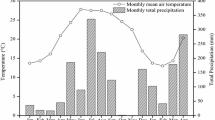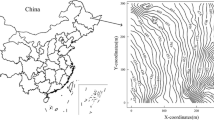Abstract
Soil respiration (SR), a substantial component of the forest carbon budget, has been studied extensively at the ecosystem, regional, continental, and global scales, but little progress has been made toward understanding SR over managed forest landscapes. Soil respiration is often influenced by soil temperature (Ts), soil moisture (Ms), and type of vegetation, and these factors vary widely among the patch types within a landscape. We measured SR, Ts, Ms, and litter depth (LD) during the 1999 and 2000 growing seasons within six dominant patch types (mature northern hardwoods, young northern hardwoods, clear-cuts, open-canopy Jack pine barrens, mature Jack pine, and mature red pine) on a managed forest landscape in northern Wisconsin, USA. We compared SR among and within the patch types and derived empirically based models that relate SR to Ts, Ms, and LD. Increased levels of soil moisture and higher temperatures in June–September 1999 may have accounted for the up to 37% overall higher SR than in this same period in 2000. In 2000, SR and Ts values were lower, and the sites may have been experiencing slight water limitations, but in general Ts was a much more accurate predictor of SR during this year. Empirical predictions of SR within each patch type derived from continuous Ts measurements were in close agreement with measured values of SR during 2000, but eight of 22 of the simulated values were significantly different (α = 0.05) from the rates measured in 1999. The young hardwoods consistently had the highest SR, whereas the pine barrens had the lowest. Results from our field studies and empirical models can help land managers assess landscape responses to potential disturbances and climatic changes.








Similar content being viewed by others
References
Albert DA. 1995. Regional landscape ecosystems of Michigan, Minnesota, and Wisconsin: a working map and classification. USDA–Forest Service General Technical Report NC-178. St. Paul (MN): North Central Forest Experiment Station
M Alexander (1977) Introduction to soil microbiology. Wiley New York 467
N Behera SK Joshi DP Pati (1990) ArticleTitleRoot contribution to total soil metabolism in a tropical forest from Orissa, India. For Ecol Manage 36 125–34 Occurrence Handle10.1016/0378-1127(90)90020-C
KD Brosofske J Chen TR Crow (2001) ArticleTitleUnderstory vegetation and site factors: implications for a managed Wisconsin landscape. For Ecol Manage 146 75–87 Occurrence Handle10.1016/S0378-1127(00)00447-3
J Chen M Falk ES Euskirchen UK Paw K Suchanek S Ustin BJ Bond KD Brosofske N Phillips R BI (2002) ArticleTitleBiophysical controls of carbon flows in three successional Douglas-fir stands based upon eddy-covariance measurements. Tree Physiol 22 171–80 Occurrence Handle1:CAS:528:DC%2BD38XitVaksrw%3D
J Chen SC Saunders TR Crow RJ Naiman KD Brosofske GD Mroz BL Brookshire JF Franklin (1999) ArticleTitleMicroclimate in forest patch types and landscape ecology. BioScience 49 288–97
P Ciais PP Tans M Trolier JWC White RJ Francey (1995) ArticleTitleA large northern hemisphere terrestrial CO2 sink indicated by the 13C/12C ratio of atmospheric CO2. Science 269 1098–202 Occurrence Handle1:CAS:528:DyaK2MXns12msLo%3D
Crow TR, Haney A, Waller DM. 1994. Report on the scientific roundtable on biological diversity convened by the Chequamegon and Nicolet National Forests. USDA Forest Service General Technical Report NC-166. St. Paul (MN): North Central Forest Experimental Station
ES Euskirchen J Chen H Li EJ Gustafson TR Crow (2002) ArticleTitleModeling landscape net ecosystem productivity (LandNEP) under alternative management regimes. Ecol Model 154 75–91 Occurrence Handle10.1016/S0304-3800(02)00052-2 Occurrence Handle1:CAS:528:DC%2BD38XktlKhtbg%3D
KC Ewel WP Cropper HL Gholz (1987) ArticleTitleSoil CO2 evolution in Florida slash pine plantations. II. Importance of root respiration. Can J For Res 17 330–3
PJ Hanson NT Edwards CT Garten JA Andrews (2000) ArticleTitleSeparating root and soil microbial contributions to soil respiration: a review of methods and observations. Biogeochemistry 48 115–46 Occurrence Handle1:CAS:528:DC%2BD3cXitVOjsrg%3D
DM Howard PJA Howard (1993) ArticleTitleRelationships between CO2 evolution, moisture content and temperature for a range of soil types. Soil Biol Biochem 25 1537–46 Occurrence Handle10.1016/0038-0717(93)90008-Y
Janssens IA, Lankreijer H, Matteucci G, Kowalski AS, Buchmann N, Epron D, Pilegaard K, Kutsch W, Longdoz B, Grünwald T, and others. 2001. Productivity overshadows temperature in determining soil and ecosystem respiration across European forest. Global Change Biol 7:269–78
TW Jurik GM Briggs DM Gates (1991) ArticleTitleSoil respiration of five aspen stands in northern lower Michigan. Am Midl Nat 126 68–75
DW Kicklighter JM Melillo WT Peterjohn EB Rastetter AD McGuire PA Steudler JD Aber (1994) ArticleTitleAspects of spatial and temporal aggregation in estimating regional carbon dioxide fluxes from temperate and forest soils. J Geophys Res 99 1303–5 Occurrence Handle1:CAS:528:DyaK2cXkvVOqt74%3D
J Lloyd A Taylor (1994) ArticleTitleOn the temperature dependence of soil respiration. Funct Ecol 8 315–23
AJ Londo MG Messina SH Schoenholtz (1999) ArticleTitleForest harvesting effects on soil temperature, moisture, and respiration in a bottomland hardwood forest. Soil Sci Soc Am J 63 637–44 Occurrence Handle1:CAS:528:DyaK1MXks1ajur8%3D
Y Luo S Wan D Hui L Wallace (2001) ArticleTitleAcclimatization of soil respiration to warming in a tall grass prairie. Nature 413 622–5 Occurrence Handle10.1038/35098065 Occurrence Handle1:CAS:528:DC%2BD3MXnslegtL4%3D Occurrence Handle11675783
RB Myneni J Dong CJ Tucker RK Kaufmann PE Kauppi J Liski L Zhou V Alexeyev MK Hughes (2001) ArticleTitleA large carbon sink in the woody biomass of northern forests. Proc Natl Acad Sci USA 98 14784–9 Occurrence Handle10.1073/pnas.261555198 Occurrence Handle1:CAS:528:DC%2BD38XptlGl Occurrence Handle11742094
Pacala SW, Hurtt GC, Baker D, Peylin P, Houghton RA, Birdsey RA, Heath L, Sundquist ET, Stallard RF, Ciais P, and others. 2001. Consistent land- and atmosphere-based 2001. Consistent land- and atmosphere-based U.S. carbon sink estimates. Science 292:2316–20
LW Parker J Miller Y Steenberg WG Whitford (1983) ArticleTitleSoil respiration in a Chihuahuan Desert rangeland. Soil Biol Biochem 15 303–9 Occurrence Handle10.1016/0038-0717(83)90075-5
JW Raich KJ Nadelhoffer (1989) ArticleTitleBelowground carbon allocation in forest ecosystems: global trends. Ecology 70 1346–54
JW Raich CS Potter (1995) ArticleTitleGlobal patterns of carbon dioxide emissions from soils. Global Biogeochem Cycles 9 23–36 Occurrence Handle1:CAS:528:DyaK2MXktFGitL0%3D
JW Raich WH Schlesinger (1992) ArticleTitleThe global carbon dioxide flux in soil respiration and its relationship to vegetation and climate. Tellus 44B 81–99 Occurrence Handle1:CAS:528:DyaK38XksVOgsLY%3D
JW Raich A Tufekcioglu (2000) ArticleTitleVegetation and soil respiration: correlations and controls. Biogeochemistry 48 71–90 Occurrence Handle10.1023/A:1006112000616 Occurrence Handle1:CAS:528:DC%2BD3cXitVOjsro%3D
WA Reiners (1968) ArticleTitleCarbon dioxide evolution from the floor of three Minnesota forests. Ecology 49 471–83
JA Rice (1995) Mathematical statistics and data analysis. 2nd ed Wadsworth Belmont (CA) 602
CA Russell RP Voroney (1998) ArticleTitleCarbon dioxide efflux from the floor of a boreal aspen forest. I. Relationship to environmental variables and estimates of C respired. Can J Soil Sci 78 301–10
Saunders SC. 1998. Multiscale relationships between pattern and process in a managed forest landscape [dissertation]. Michigan Technological University, Houghton, MI, USA
SC Saunders J Chen TD Drummer TR Crow (1999) ArticleTitleModeling temperature gradients across edges over time in a managed landscape. For Ecol Manage 117 17–31 Occurrence Handle10.1016/S0378-1127(98)00468-X
SC Saunders J Chen TD Drummer TR Crow KD Brosofske EJ Gustafson (2002) ArticleTitleThe patch mosaic and ecological decomposition across spatial scales in a managed landscape of northern Wisconsin, USA. Basic Appl Ecol 3 49–64
KE Savage EA Davidson (2001) ArticleTitleInterannual variation of soil respiration in two New England forests. Global Biogeochem Cycles 15 337–50 Occurrence Handle1:CAS:528:DC%2BD3MXktlWhsb8%3D
Schimel D, Melillo J, Tian H, McGuire AD, Kicklighter D, Kittel T, Rosenbloom N, Running S, Thornton P, Ojima D, and others. 2000. Contribution of increasing CO2 and climate to carbon storage by ecosystems in the United States. Science 287:2004–6
RE Schlenter K Van Cleve (1985) ArticleTitleRelationships between CO2 evolution from soil, substrate temperature, and substrate moisture in four mature forest types in interior Alaska. Can J For Res 15 97–106
E-D Schulze C Wirth M Heimann (2000) ArticleTitleManaging forests after Kyoto. Science 289 2058–9 Occurrence Handle10.1126/science.289.5487.2058 Occurrence Handle1:CAS:528:DC%2BD3cXmvVCnu7g%3D Occurrence Handle11032555
JA Simmons IJ Fernandez RD Briggs MT Delaney (1996) ArticleTitleForest floor carbon pools and fluxes along a regional climate gradient in Maine, USA. For Ecol Manage 84 81–95 Occurrence Handle10.1016/0378-1127(96)03739-5
RG Striegl KP Wickland (2001) ArticleTitleSoil respiration and photosynthetic uptake of carbon dioxide by ground-cover plants in four ages of Jack pine forest. Can J For Res 31 1540–50 Occurrence Handle10.1139/cjfr-31-9-1540 Occurrence Handle1:CAS:528:DC%2BD3MXot1CksrY%3D
V Thierron H Laudelout (1996) ArticleTitleContribution of root respiration to total CO2 efflux from the soil of a deciduous forest. Can J For Res 26 1142–8
H Tian JM Melillo DW Kicklighter AD McGuire J Helfrich (1999) ArticleTitleThe sensitivity of terrestrial carbon storage to historical climate variability and atmospheric CO2 in the United States. Tellus 51B 414–52 Occurrence Handle1:CAS:528:DyaK1MXktF2lu74%3D
DE Toland DR Zak (1994) ArticleTitleSeasonal patterns of soil respiration in intact and clear-cut northern hardwood forests. Can J For Res 24 1711–6
Valentini R, Matteucci G, Dolman AJ, Schulze E-D, Rebmann C, Moors EJ, Granier A, Gross P, Jensen NO, Pilegaard K, and others. 2000. Respiration as the main determinant of carbon balance in European forests. Nature 404:861–5
B Widén H Majdi (2001) ArticleTitleSoil CO2 efflux and root respiration at three sites in a mixed pine and spruce forest: seasonal and diurnal variation. Can J For Res 31 786–96 Occurrence Handle10.1139/cjfr-31-5-786
RE Wildung TR Garland RL Buschborn (1975) ArticleTitleThe interdependent effects of soil temperature and water content on soil respiration rate and plant root decomposition in arid grassland soil. Soil Biol Biochem 7 373–8 Occurrence Handle10.1016/0038-0717(75)90052-8 Occurrence Handle1:CAS:528:DyaE28XhtlClsrc%3D
M Xu Y Qi (2001) ArticleTitleSoil Global Change Biol 6 667–77 Occurrence Handle10.1046/j.1354-1013.2001.00435.x
Acknowledgements
This research was funded by a US Department of Agriculture (USDA) competitive grant (97-35101-4315), the Research Excellence Funds of Michigan, a cooperative research grant with USDA Forest Service North Central Research Station (23-94-12), and the National Science Foundation. Many thanks to Treneice Marshall, Rob Spence, Kimberly Brosofske, Dzung Pham, Jim LeMoine, and the USDA Forest Service, Chequamegon National Forest for helping with field data collection and for providing logistical support. Niall Hanan and an anonymous reviewer provided valuable suggestions on an earlier draft of this manuscript.
Author information
Authors and Affiliations
Corresponding author
Rights and permissions
About this article
Cite this article
Euskirchen, E., Chen, J., Gustafson, E. et al. Soil Respiration at Dominant Patch Types within a Managed Northern Wisconsin Landscape . Ecosystems 6, 595–607 (2003). https://doi.org/10.1007/PL00021505
Received:
Accepted:
Published:
Issue Date:
DOI: https://doi.org/10.1007/PL00021505




